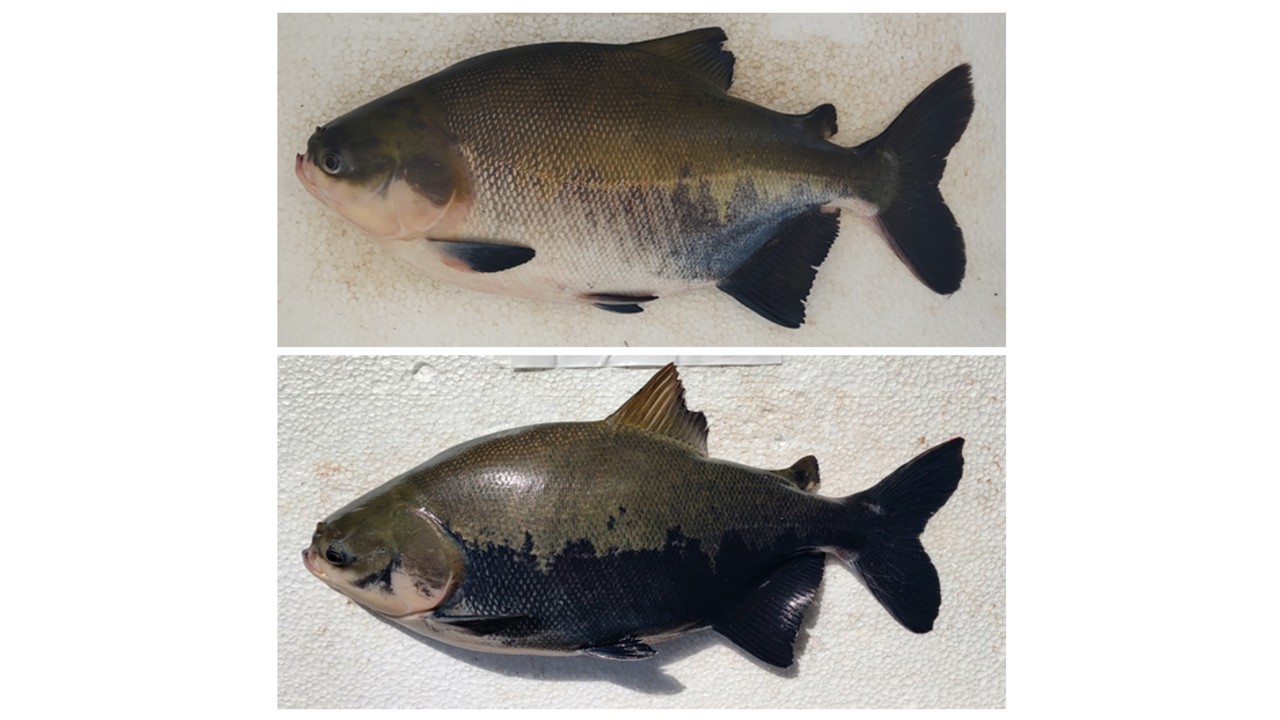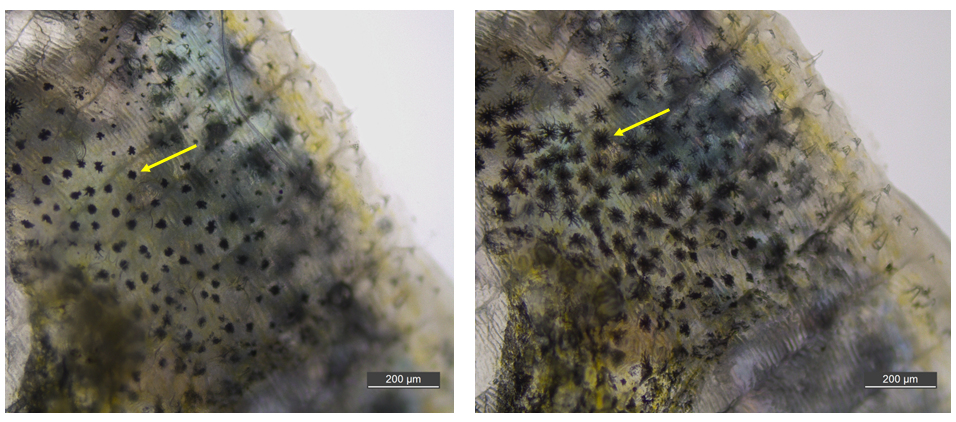

Above, a tambaqui fish fresh out of a normal breeding tank. Below, the same animal, more stressed and darker after 10 days in a 2,000-liter confinement tank (photo: Celma Lemos/CAUNESP)
Brazilian researchers have developed a tool that can be used to improve animal welfare by assessing tambaqui fish based on the coloration of the lower half of their bodies. Brazil is the world’s largest producer of this species.
Brazilian researchers have developed a tool that can be used to improve animal welfare by assessing tambaqui fish based on the coloration of the lower half of their bodies. Brazil is the world’s largest producer of this species.

Above, a tambaqui fish fresh out of a normal breeding tank. Below, the same animal, more stressed and darker after 10 days in a 2,000-liter confinement tank (photo: Celma Lemos/CAUNESP)
By André Julião | Agência FAPESP – In Brazil, a group led by researchers from São Paulo State University (UNESP) in Jaboticabal, in collaboration with the Brazilian Agricultural Research Corporation (EMBRAPA), has developed an artificial intelligence (AI) tool to assess the stress levels of tambaqui (Colossoma macropomum), the most widely produced native fish in Brazil. The study was published in the journal Aquaculture.
The results could impact both animal welfare and the selection of specimens that are more tolerant of the farming environment. Tambaqui is an Amazonian species primarily farmed in the northern states. Brazil is the world’s largest producer of the species, supplying 110,000 tons in 2022 (read more at agencia.fapesp.br/54533 and agencia.fapesp.br/38000).
“First, we found that in stressful conditions, that is, in a more confined environment than normal, the fish became darker. Then, we saw that the addition of a stress-related hormone also altered the coloration of the scales. So we trained software with more than 3,000 images to arrive at a stress threshold that could guide fish farmers and genetic selection programs, as we saw that this is a heritable trait,” explains Diogo Hashimoto, a professor at the UNESP Aquaculture Center (CAUNESP) who coordinated the study.
Celma Lemos, a doctoral student at the institution, is the first author of the study. She is part of a project supported by FAPESP under an agreement with the Amazonas State Research Support Foundation (FAPEAM).
To develop the tool, the researchers photographed 3,780 tambaqui from two populations: one from CAUNESP (1,280 individuals) and the other from EMBRAPA Fisheries and Aquaculture in Palmas, in the state of Tocantins (2,500 individuals), with the collaboration of the team coordinated by researcher Luciana Shiotsuki.
Next, the lower half of the body was marked on each image for evaluation by the software. Contrast with the coloration of the upper part is common in fish and is probably an attribute of natural selection that has resulted in a kind of camouflage. This phenomenon, known as countershading, can be observed in sharks, for example, which have a lighter belly than their backs.
The researchers then trained a deep learning model to determine a threshold based on the ratio of black to white pixels in an image to indicate the degree of stress in the tambaqui.
Since the Tocantins specimens had been marked according to their ancestry, they were able to determine the extent to which the trait can be passed on. “We estimate that stress tolerance is a moderately to highly heritable trait. This is reflected in weight gain and disease tolerance, paving the way for generations with increasing well-being in a farming environment,” says Hashimoto.
Physiological mechanisms
Several fish species exhibit a change in coloration under stress, but this trait had not yet been proven in tambaqui. In species that become darker under stress, such as tilapia (Oreochromis niloticus), a stress-related hormone promotes the expansion of melanophores, which are cells that appear as small black spots to the naked eye.
To demonstrate this effect in tambaqui, the researchers collected scales from six individuals of the Jaboticabal population and immersed them in two solutions. One solution contained a neutral substance and α-MSH (a version of the melanocyte-stimulating hormone), and the other contained only the neutral substance. After 30 minutes, the researchers observed that the scales bathed in the hormone solution were darker, with expanded melanocytes.

Scales before and after 30 minutes immersed in a solution with a stress-related hormone. The expansion of melanophores, indicated by the arrow, causes darker coloring (photo: Celma Lemos/CAUNESP)
In another experiment, six tambaqui were removed from their normal 200-square-meter breeding tanks. They were photographed and then divided into three much smaller, round reservoirs. Each reservoir had a capacity of 2,000 liters and measured 85 centimeters in height and 1.66 meters in diameter. After ten days, the fish were photographed again, revealing a difference in coloration that confirmed the species becomes darker when stressed.
“The AI tool can be used to monitor the stress of farmed fish at a time when animal welfare is increasingly demanded. By simply evaluating photos of the animals, it would be possible to obtain this measurement and improve practices when necessary, such as reducing the number of individuals per tank, for example,” says the researcher.
The article “Deep learning approach for genetic selection of stress response in the Amazon fish Colossoma macropomum” can be read at www.sciencedirect.com/science/article/abs/pii/S0044848625007343.
Republish
The Agency FAPESP licenses news via Creative Commons (CC-BY-NC-ND) so that they can be republished free of charge and in a simple way by other digital or printed vehicles. Agência FAPESP must be credited as the source of the content being republished and the name of the reporter (if any) must be attributed. Using the HMTL button below allows compliance with these rules, detailed in Digital Republishing Policy FAPESP.





